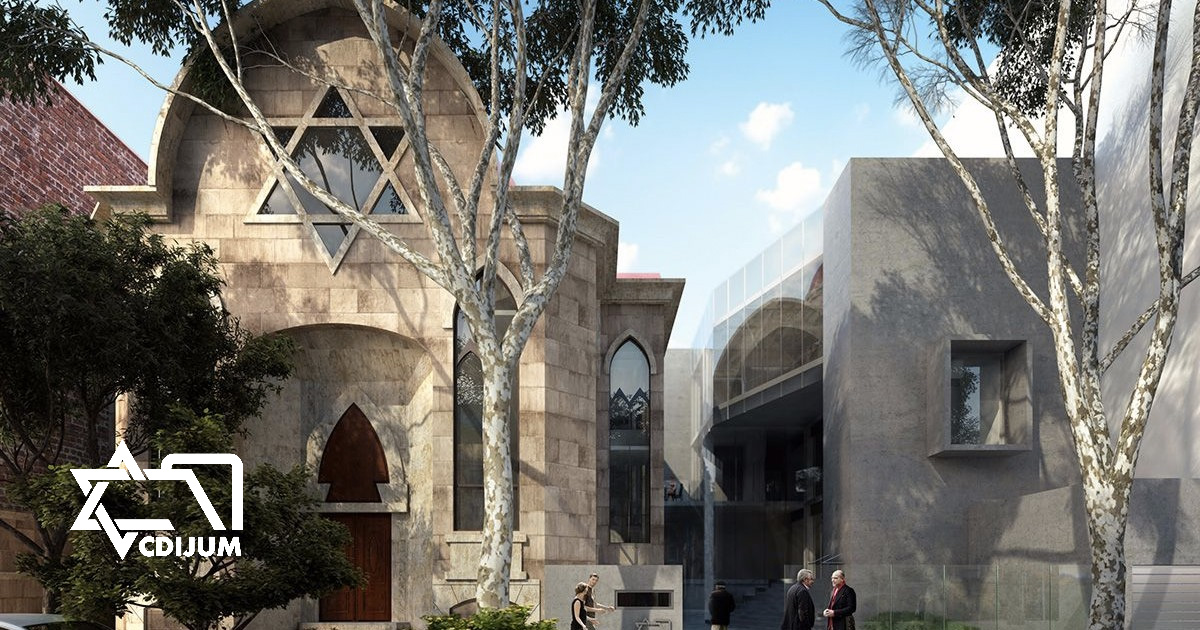A catastrophic 1985 earthquake that killed thousands of people in Mexico City and destroyed the (back-then) Jewish neighborhoods of Roma and Condesa also left the archives of the Ashkenazi community in a state of complete disarray, stashed away in makeshift boxes in the damp and dark basement of the Nidje Israel synagogue, colloquially known as Acapulco 70 for its street address. In the early 1990s, Alicia Gojman de Backal, a history professor at the National University of Mexico, decided to make sense of this archival nightmare. The result was Generations of Jews in Mexico a seven-tome encyclopedic history of the Ashkenazi community in Mexico published in 1993 and the birth of Mexico City’s Jewish Documentation Center, which will reopen this week in its new home in the historical Rodfe Sedek synagogue.
The JDC archive includes Mexican anti-Semitic and anti-fascist posters of the 1930s, original manuscripts by the Yiddish poet Jacobo Glanz, and the first edition of The City of Palaces, one of the first Yiddish books published in Mexico, with poems by Isaac Berliner and original drawings by Diego Rivera (the communist artist was close to many left-wing Jewish émigrés). The reopened collection also celebrates more than 100 years of Jewish immigration from Syria, Turkey, the Balkans, Morocco, Iraq, and many more countries, which will be added to a collection that was awarded Memory of the World status by UNESCO, placing it in the same level as the nations’ top collections of pre-Hispanic codices.
According to those involved in the project, the idea of the JDC was to find a final resting place for the community’s archives—which, in the case of the Ashkenazi documents, needed to be relocated yet again last year, after a magnitude 7.1 earthquake struck the city on the exact same date as the mythic 1985 quake. In order to preserve the documents, Enrique Chmelnik, director of the new center, had to design an impromptu exit strategy to save them from the collapsing building.
I recently met Chmelnik in his temporary headquarters, provided by the Syrian Jewish community in the suburban neighborhood of Tecamachalco, where most Jews now live. In a small room outside his office were cardboard boxes about to burst with papers, hundreds of newspapers stacked in makeshift Ikea-style closets, and many more documents lying, randomly, on a large table. (Later, I found that most of the archives had been stored temporarily in a warehouse in the outskirts of the city.) On top of a cupboard was collection of Yiddish-script typewriters, including a Remington Portable produced in the 1940s in New York.
The staff members were busy with these treasures, getting ready to move out. Raquel Castro, who writes the center’s newsletter, showed me a photo album donated by one of the community members: “Just like vets sometimes receive a box full of kittens that no one knows where they came from, or what to do with them, people sometimes drop boxes of documents and personal material on our doorsteps … and we have no idea where they came from or who the people in the pictures are.”
One of the most important documents in the new center was donated by the Monte Sinai community, which represents the Jews who immigrated from Damascus. The paper documents the first Jewish organization, established in 1912, when a group of Jews from the Balkans, Eastern Europe, Libya, and Syria, decided to join forces in order to buy a plot of land for use as a cemetery. “It’s ironic,” Chmelnik told me, smiling, “100 years ago, all these Jews from diverse backgrounds got together with a common goal in mind.”
Since then, the century-old community has branched out into many subcommunities divided by place of origin. Today there are synagogues, community centers, and schools for Jews from the ex-Ottoman Empire or Syria, Eastern Europe, or the United States. Place of origin is so important in the Maguen David (Aleppo) and Monte Sinai (Damascus) communities that there are special genealogy programs in order to prove that each member has Jewish-Syrian descendants going back four or five generations.
This sense of separation and hyperfragmentation within the community has generated its own microidentity politics: Different histories are being told according to separate archives. Separation is such that Chmelnik, himself an Ashkenazi Jew, did not meet a Jew from another background until he was in high school. “In a sense, there’s a type of historic justice,” he told me, when talking about the Jewish Documentation Center, “everyone is coming back under the same roof.”
The new center will have a library with 16,000 books in Spanish, Arabic, French, Hebrew, Hungarian, Yiddish, Ladino, English, Lithuanian, Polish, and Russian, many of them rescued by the Allies during World War II. It will also house 1,500 newspapers coming from as far away as Istanbul, a collection of pictures documenting everyday life for Jews in Mexico, and original copies of the first Yiddish newspapers published in the city.
I went to visit the new center recently; the modern cement-and-glass building, with its sharp edges and open rooms, contrasts with the adjacent synagogue, with its brick walls and beautiful colored-plated glass windows. The first floor of the restored synagogue already has a sizable collection of books; newspapers will be kept on the second floor.
As for the archives, they will be stored in fireproof, secure, and movable metal shelves in the basement, where there is a beautiful mikvah, the first one in Mexico City. The documents will be organized according to community of origin. The room they are stored in is also said to be earthquake proof.


























